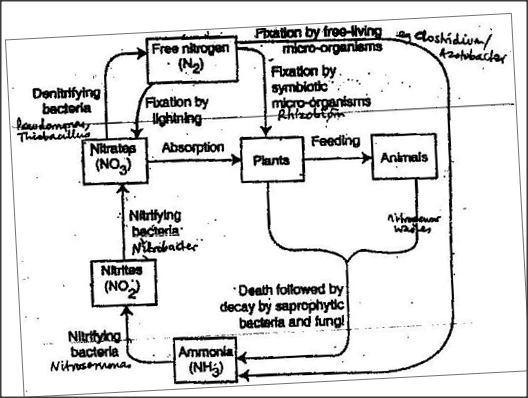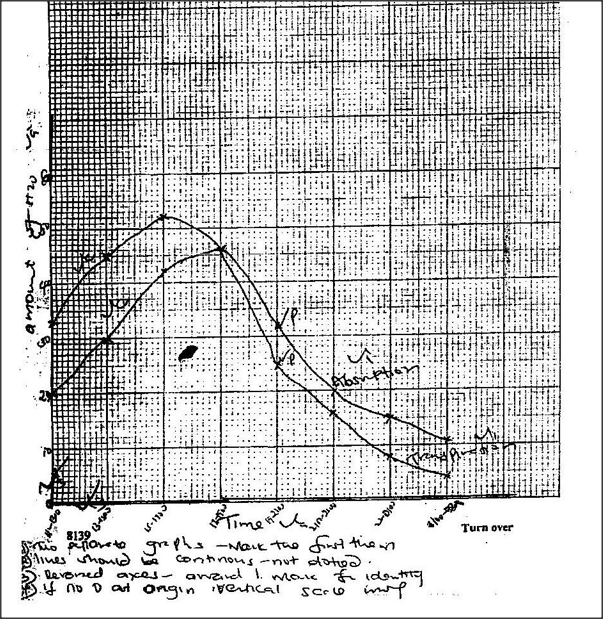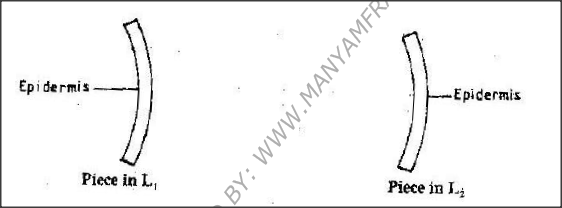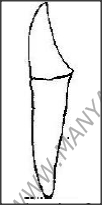|
K.C.S.E Biology Q & A - MODEL 2008PP2QN08
Describe the mechanism of gaseous exchange in a mammal
answers
Breathing in
External intercostals muscles contract; internal, intercostals muscles relax lifting/ raising the ribcage upwards and outwards; muscles of diaphragm contract. It flattens the volume of the thoracic cavity increases; pressure decrease; higher air pressure in the atmosphere forces air into the lungs Breathing out External intercostals/ muscles relax; internal intercostals muscles contract moving the ribcage downwards and inwards; the muscles of diaphragm relax, the diaphragm assumes dome shape; volume of thoracic cavity decreases; while pressure increases; higher pressure forces air out of the lungs
0 Comments
K.C.S.E Biology Q & A - MODEL 2008PP2QN08
State four characteristics of gaseous exchange surfaces
answers
K.C.S.E Biology Q & A - MODEL 2008PP2QN07
Describe the nitrogen cycle
answers
During thunderstorm/ lightning; nitrogen gas combines with O2 to form nitrogen oxides; nitrogen oxides dissolve in water to for nitric acid; acid is deposited in the soil by rain, nitric acid combines with chemical substance to form nitrates/ nitric acids dissolves to form nitrates which are absorbed by plants symbiotic bacteria/ such as rhizobium; which are found in root nodules of leguminous plants, fix free nitrogen to nitrates.
Free living bacteria/ clatridium/ azotobacteria fix nitrogen to all rates Nostoc algae/ chlorella/ anaemia/ ix nitrogen to nitrates. Plants use Nitrates to form plant proteins Animals feed on plants and convert plant proteins into animal proteins Plants/ animals die and decomposed by bacteria/ saprophytes/ fungi decomposing plants/ animals/ release ammonia which is covered to nitrates/ by nitrosomomes nitrococcus bacteria Nitrates are converted to nitrates; by nitrobacteria Nitrates in the soil can be converted to free nitrogen/ denitrification by some fungi; pseudomonas/ hulobacillus denitrifying bacteria. K.C.S.E Biology Q & A - MODEL 2008PP2QN06
An experiment was carried out to investigate transpiration and absorption of water in sunflower plants in their natural environment with adequate supply of water. The account of water was determined in two hour intervals. The results are as shown in the table below
(a) Using the same axes, plot graphs to show transpiration and absorption of water in grammes against time of the day
(b) At what time of the day was the amount of water the same for transpiration and absorption? (c) Account for the shape of graph of: (i) Transpiration (ii) Absorption (d) What would happen to transpiration and absorption of water if the experiment was continued till 05 00 hours? (e) Name two factors that may affect transpiration and absorption at any given time (f) Explain how the factors you named in (e) above affect transpiration
answers
(b) 17.001- 19.99 hrs
(c) (i) Transpiration 1100 – 17000 (rapid) ( in the rate of transpiration) due to high light intensity/ high temperature (ii) 17000 – 0300 hrs decrease (in the rate of transpiration) due to low light intensity/ absence of light/ in temperature. (iii) Absorption 11.00 – 1900 hrs. Increase (in the rate of atmosphere) of water to replace water lost- through transpiration 1900 – 0300 hrs; decrease ( in the rate of absorption of water) due to the fact that rate of transpiration has declined (d) Both transpiration and absorption decrease accept decrease (e) Wind; light, atmosphere pressure, humidity; temperature Temperature - at high temperature the rate is higher/ at low temperature the rate is Low. (f) Wind- rate of transpiration is high when it’s windy/ lower when air still Humidity – when humidity is low, the rate of transpiration is faster/ when its High the rate of transportation is low Pressure- the rate is high at low atmosphere pressure at high atmosphere pressure the rate is low. K.C.S.E Biology Q & A - MODEL 2008PP2QN05
A freshly obtained dandelion stem measuring 5 cm long was split lengthwise to obtain two similar pieces The pieces were placed in solutions of different concentrations in Petri dishes for 20 minutes.
The appearance after 20 minutes is as shown
(a) Account for the appearance of the pieces in solutions L1 and L2
(b) State the significance of the biological process involved in the experiment
answers
(a) L1
Inner cells gained water by Osmosis; hence increased in length; epidermal cells did not gain water because they are covered by a water proof cuticle leading to currature. L2 Inner cells lost water by osmosis; leading to (flaccidity) decrease in length; epidermal cells did not lose water due to waterproof leading to currature (b) Support in (herbaceous) plants Absorption of water Opening and closing of stomata Movement of water from cell to cell Leading in infectious plants Folding of leaves in the Mimosa
K.C.S.E Biology Q & A - MODEL 2008PP2QN04
Why is movement necessary in animals
answers
K.C.S.E Biology Q & A - MODEL 2008PP2QN04
Give three reasons in each case why support is necessary in
(i) Plants (ii) animals
answers
(i) Plants
K.C.S.E Biology Q & A - MODEL 2008PP2QN03
The equation below represents a process that takes place in plants
6CO2 + 6H2O→C6H12O6 + 602 (a) Name the process (b) State two conditions necessary for the process to take place (c) State what happens to the end- products of the process
answers
(a) Photosynthesis
(b) Light (energy) Chlorophyll (c) Oxygen – used in respiration, oxidation Released into the atmosphere Glucose – used in respiration Converted to sucrose or starch for storage Used in formation of sturdiness allulose cell wall/ cytoplasm
K.C.S.E Biology Q & A - MODEL 2008PP2QN02
What is a test – cross?
answers
K.C.S.E Biology Q & A - MODEL 2008PP2QN02
A pea plant with round seeds was crossed with a pea plant that had Wrinkled seeds the gene for round seeds is dominant over that for wrinkled seeds
Using letter R to represent the dominant gene state: (a) The genotype of parents if plant with round seed was heterozygous (b) The gametes produced by the round and wrinkled seed parents
K.C.S.E Biology Q & A - MODEL 2008PP2QN01
The figure shows changes that take place during menstrual cycle in human
(a) Name the hormone whose concentrations are represented by curves F and G
(b) State the effects of the hormones named in (a) above on the lining of the uterus (c) (i) Name the hormone which is released by the pituitary gland in high concentration on the 14th day of the menstrual cycle (ii) State two functions of the hormone named in (c) (I ) above (d) State the fertile period during the menstrual cycle
answers
(a) Oestrogen
Progesterone (b) Promotes healing (promotes repair (of the uterus) Causes thickening (of the uterine lining) vasculation (c) (i) Leutinizing hormone (ii) Causes ovulation Induces graafian follicle to become corpus iterum Stimulates corpus inteum to release progesterone (d) 12th , 16th , 14 + 2
K.C.S.E Biology Q & A - MODEL 2008PP1QN29
State a function of amniotic fluid.
answer
K.C.S.E Biology Q & A - MODEL 2008PP1QN28
Distinguish between protandry and protogyny.
answers
K.C.S.E Biology Q & A - MODEL 2008PP1QN28
State the mode of asexual reproduction in yeast.
answer
K.C.S.E Biology Q & A - MODEL 2008PP1QN27
Explain how anaerobic respiration is applied in sewage treatment.
answers
K.C.S.E Biology Q & A - MODEL 2008PP1QN26
State one use of each of the following excretory products of plants:
(a) colchicine; (b)pawpaw
answers
(a) Inducing polyploidy/ treatment
(b) Meat tenderizer K.C.S.E Biology Q & A - MODEL 2008PP1QN30
The diagram below shows two fused bones of a mammal
(a) Identify the fused bone
(b) Name the (i) Bone that articulates at the point labelled F (ii) The hole labelled G
ANSWERS
(a)Pelvic girdle
(b) (i) Femur (ii) Obturatar foramen. K.C.S.E Biology Q & A - MODEL 2008PP1QN25
Giving a reason in each case, name the class to w which each of the following organisms
Bean plant Reason Bat Reason
ANSWERS
Bean plant - Dicotyledonae
Reason Leaves have net veined; two cotyledon; tap root system; xylem with phloem in between the arms Bat Flying mammal Reason Have sweat glands; 3 ear ossicle; presence of fur; mammaring glands K.C.S.E Biology Q & A - MODEL 2008PP1QN24
Name the sites where light and dark reactions of photosynthesis take place
Light reaction Dark reaction
ANSWERS
K.C.S.E Biology Q & A - MODEL 2008PP1QN23
The diagram below shows a human tooth
(a) Identify the tooth
(b) How is the tooth adapted to its function (c) State the role of the following vitamins in the human body (i) C (ii) K
ANSWERS
(a) Canine
(b) Pointed/ sharp for piercing/ tearing/ cutting food (c) (i) C- Absorption of lien/ prevent scurvy/ quick healing of wounds/ best immunity/ ant oxidants/ prevents anaemia/ formation of connective tissues/ K – blood clothing
K.C.S.E Biology Q & A - MODEL 2008PP1QN21
What is seed dormancy
ANSWER
K.C.S.E Biology Q & A - MODEL 2008PP1QN20
Name the opening to the chamber of the heart of an insect
ANSWER
K.C.S.E Biology Q & A - MODEL 2008PP1QN20
Name an organism which has single circulatory system
ANSWERS
|
Archives
December 2024
Categories
All
TOPICSFORM 1
Form 2
Form 3
Form 4
|
Can't find what you are looking for? Don't worry, Use the Search Box Below.
|
Primary Resources
College Resources
|
Secondary Resources
|
Contact Us
Manyam Franchise
P.O Box 1189 - 40200 Kisii Tel: 0728 450 424 Tel: 0738 619 279 E-mail - sales@manyamfranchise.com |















 RSS Feed
RSS Feed

